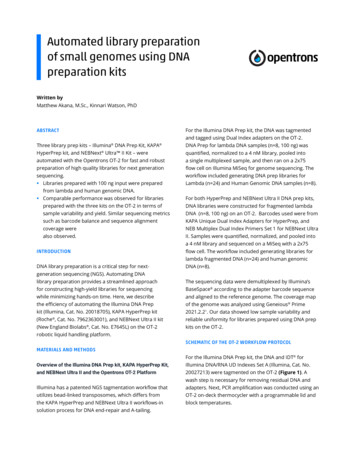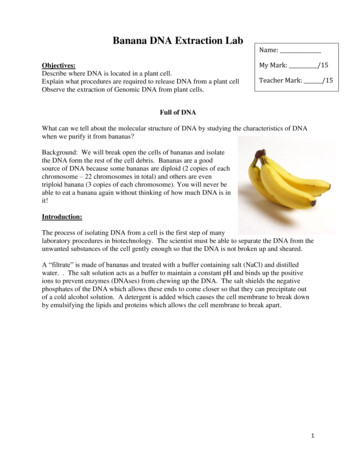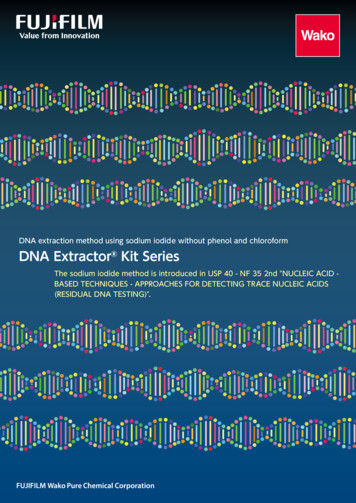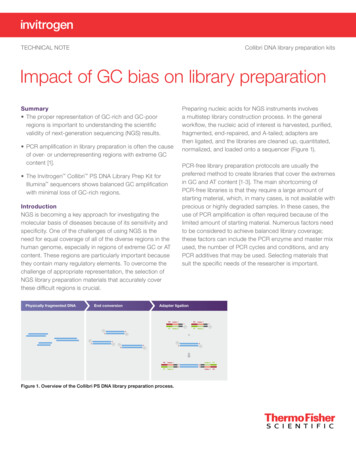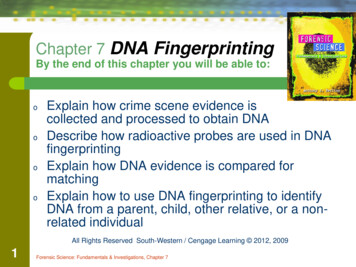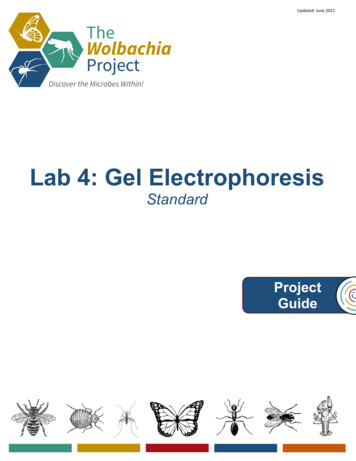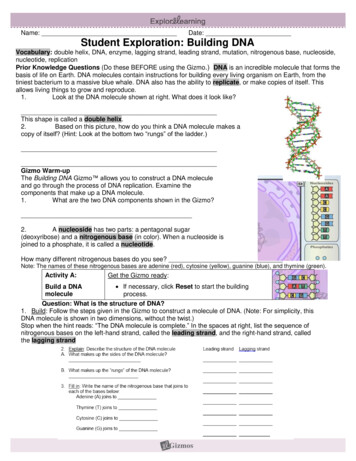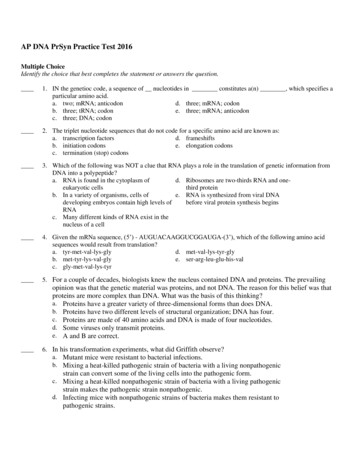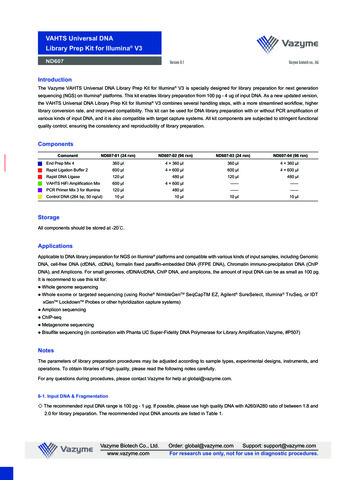
Transcription
VAHTS Universal DNALibrary Prep Kit for Illumina V3ND607Version 8.1Vazyme biotech co., ltd.IntroductionThe Vazyme VAHTS Universal DNA Library Prep Kit for Illumina V3 is specially designed for library preparation for next generationsequencing (NGS) on Illumina platforms. This kit enables library preparation from 100 pg - 4 ug of input DNA. As a new updated version,the VAHTS Universal DNA Library Prep Kit for Illumina V3 combines several handling steps, with a more streamlined workflow, higherlibrary conversion rate, and improved compatibility. This kit can be used for DNA library preparation with or without PCR amplification ofvarious kinds of input DNA, and it is also compatible with target capture systems. All kit components are subjected to stringent functionalquality control, ensuring the consistency and reproducibility of library preparation.ComponentsND607-01 (24 rxn)ND607-02 (96 rxn)ND607-03 (24 rxn)ND607-04 (96 rxn)End Prep Mix 4Comonent360 µl4 360 µl360 µl4 360 µlRapid Ligation Buffer 2600 µl4 600 µl600 µl4 600 µlRapid DNA Ligase120 µl480 µl120 µl480 µlVAHTS HiFi Amplification Mix600 µl4 600 µl------------PCR Primer Mix 3 for Illumina120 µl480 µl------------Control DNA (264 bp, 50 ng/ul)10 µl10 µl10 µl10 µlStorageAll components should be stored at -20 .ApplicationsApplicable to DNA library preparation for NGS on Illumina platforms and compatible with various kinds of input samples, including GenomicDNA, cell-free DNA (cfDNA, ctDNA), formalin fixed paraffin-embedded DNA (FFPE DNA), Chromatin immuno-precipitation DNA (ChIPDNA), and Amplicons. For small genomes, cfDNA/ctDNA, ChIP DNA, and amplicons, the amount of input DNA can be as small as 100 pg.It is recommend to use this kit for: Whole genome sequencing Whole exome or targeted sequencing (using Roche NimbleGenTM SeqCapTM EZ, Agilent SureSelect, Illumina TruSeq, or IDTxGenTM LockdownTM Probes or other hybridization capture systems) Amplicon sequencing ChIP-seq Metagenome sequencing Bisulfite sequencing (in combination with Phanta UC Super-Fidelity DNA Polymerase for Library Amplification,Vazyme, #P507)NotesThe parameters of library preparation procedures may be adjusted according to sample types, experimental designs, instruments, andoperations. To obtain libraries of high quality, please read the following notes carefully.For any questions during procedures, please contact Vazyme for help at global@vazyme.com.6-1. Input DNA & Fragmentation The recommended input DNA range is 100 pg - 1 µg. If possible, please use high quality DNA with A260/A280 ratio of between 1.8 and2.0 for library preparation. The recommended input DNA amounts are listed in Table 1.Vazyme Biotech Co., Ltd.www.vazyme.comOrder: global@vazyme.comSupport: support@vazyme.comFor research use only, not for use in diagnostic procedures.
Table 1. Recommended Amount of Input DNAApplicationSample TypeRecommended Amount of Input DNAWhole Genome SequencingComplex gDNA50 ng - 1 μgTargeted SequencingComplex gDNA0 ng - 1 μgWhole Genome SequencingMicrobial genome1 ng - 1 μgWhole Genome Sequencing (PCR-Free)Complex/Simple genomeWhole Genome/Targeted SequencingFFPE DNA 50 ngWhole Genome/Targeted SequencingcfDNA/ctDNA 100 pgTargeted SequencingAmplicons 100 pgChIP-seqChIP DNA 100 pg 50 ng (no size selection) 200 ng (with size selection) The amount recommended above is for DNA with high quality. For DNA with low quality, however, the input amount should be increased. “Input DNA” typically refers to the input DNA added to the End Preparation, instead of the input amount for Fragmentation. If DNA wasquantified before fragmentation, and fragmented DNA was subjected to cleanup or size selection prior to End Preparation, the actualinput into library construction may need to be recalculated. Otherwise, low library amplification cycle number may lead to low library yield. DNA preparations containing high concentrations of EDTA, other chelating agents, or salts may affect the End Preparation reaction.(1). Purify or size select fragmentation products and then dilute the purification products to 0.1 TE or ddH2O ( 50 µl) before libraryconstruction.(2). If fragmented DNA is not subjected to a bead-based cleanup or size selection prior to library construction:For mechanical fragmentation, DNA should be fragmented in 0.1 TE. Fragmentation in water is not recommended.For enzymatic fragmentation, make sure there is no EDTA or other chelating agents in the Stop Buffer.6-2. Adapters For Illumina platforms, please choose appropriate Indexed Adapters. Vazyme VAHTS Adapters are recommended to use with this kit: Vazyme, #N801/N802: up to 24 kinds of single-ended 6-bp Indexed Adapters, 12 kinds/each set; Vazyme, #N805/N806/N807/N808: up to 96 kinds of single-ended 8-bp Indexed Adapters, 24 kinds/each set. Vazyme, #N321/N322: up to 384 kinds of dual-ended 8-bp Indexed Adapters.This kit is also compatible with non-indexed, single-indexed, and dual-indexed adapters that are routinely used in Illumina TruSeq ,Roche NimbleGenTM SeqCapTM EZ, Agilent SureSelect, and other similar library construction and targeted capture workflows. Customized adapters that are of similar design and are compatible with “TA-ligation” of dsDNA may also be used. The quality and amount of Adapters directly affect the preparation efficiency and library quality. The recommended ratio of adapter : inputis between 10 : 1 and 200 : 1. High Adapter input may lead to residual Adapter/Adapter Dimer. Low Adapter input may affect ligationefficiency and reduces library yields. Please refer to Table 2 for the recommended adapter concentrations for different DNA inputs.Table 2. Recommended adapter concentrations for libraries prepared from 100 pg - 1 µg input DNAInput DNAAdapter : Input DNAAdapter concentrationVazyme AdapterMolar Ratiofrom other sourceDilution Ratio500 ng - 1 μg10:1 - 20:110 μMUndiluted100 ng - 500 ng20:1 - 100:110 μMUndiluted25 ng - 100 ng50:1 - 200:15 μM1:25 ng - 25 ng40:1 - 200:11 μM1:10100 pg - 5 ng60:1 - 3000:10.2 μM1:30 - 1:100 Calculate the moles of Input DNA:moles of Input DNA (pmol) mass of Input DNA (ng) / [0.66 average length of Input DNA (bp)] According to the concentration or dilution ratio, dilute Adapter with 0.1 TE. Make the volume of Adapter fixed (5 µl) to avoid pipetting error. The quality of adapters will affect the molar ratio of Adapter and Input DNA and further affect ligation rate and library yields. Please see the adapter with high quality for librarypreparation. Dilute and store the Adapter solution with 0.1 TE. Minimize the number of freeze-thaw cycles. Increasing adapter inputs can increase library yields, especially when the amount of Input DNA is 25 ng. When optimizing workflows, two or three adapter concentrations shouldbe evaluated: try the recommended adapter concentration (Table 2), as well as one or two additional concentrations in a range that is 2-10 times higher than the recommendedconcentration. If the adapter concentration is limited, try using more volume to increase adapter amount. For example, if Input DNA is 500 ng-1 µg while default volume of adapteris 5 µl, please increase to 10 µl to enhance 5% - 15% library output.Vazyme Biotech Co., Ltd.www.vazyme.comOrder: global@vazyme.comSupport: support@vazyme.comFor research use only, not for use in diagnostic procedures.
6-3. Cleanup of Adapter Liagation Products Unused Adapters should be removed before library amplification (for PCR amplification library) or sequencing (for PCR-free library).The default purification condition 0.6 (60 µl beads/100 µl products) is suitable for most cases. To obtain libraries with larger insertsizes, the amount of beads can be reduced to lower the content of small DNA fragments. Please note this is just a rough adjust. Tocontrol the library distribution accurately, please process size selection after cleanup. If proceeding with size selection, an elution volume of 105 µl is recommended. If proceeding directly to library amplification, the recommended elution volume is 22.5 µl. A second cleanup may be performed if post-ligation analysis reveals unacceptable levels of adapter and/or adapter-dimer carry-overafter the first cleanup, using a 1 bead to DNA ratio. Make the volume of the purification products from the first round up to 50 µl withddH2O, and then add 50 µl of beads for second round purification. A second cleanup may be particularly beneficial when libraries areprepared in PCR-free workflows for direct sequencing on Illumina instruments. The adapter amount may also be decreased to eliminatethe residual adapter and/or adapter-dimer.6-4. Beads This protocol has been validated for use with VAHTS DNA Clean Beads (Vazyme, #N411).Notes on beads manipulations: The amount of beads is calculated by " " (multiple), indicating the multiple of beads volume compared to sample volume. Forexample, if sample volume is 100 µl, 1 beads means the volume of beads is 1 100 µl 100 µl; 0.6 /0.2 size selection meansthe first round of bead volume is 0.6 100 µl 60 µl and the second round is 0.2 100 µl 20 µl. The volume of beads directly affects the purified size of lower limit. The higher multiple, the smaller insert of lower limit, and viseversa. For example, 1 beads can only purify DNA longer than 250 bp. The smaller fragments will be discarded during cleanup. 1.8 beads can purify DNA of 150 bp. Equilibration to room temperature (place in room temperature for 30 min) is essential to achieve specified size distribution and yieldof libraries. Beads will settle gradually. Always ensure that they are fully resuspended before use by vortexing or extensive up-and-downpipetting. The time required for complete capture of beads varies according to the reaction vessel and magnet used. It is important not todiscard or transfer any beads with the removal or transfer of supernatant. Capture times should be optimized accordingly. Always use freshly prepared 80% ethanol. Keeping tubes on magnet stand without disturbing the beads during elution. It is important to remove all the ethanol before proceeding with subsequent reactions. However, over-drying of beads may makethem difficult to resuspend, resulting in a dramatic loss of DNA. With optimized aspiration of ethanol, drying of beads for 5 min–10min at room temperature should be sufficient. Drying of beads at 37 is not recommended. DNA should be eluted from beads with elution buffer (10 mM Tris-HCl, pH 8.0–pH 8.5). Elution of DNA in PCR-grade water is notrecommended, as DNA is unstable in unbuffered solutions. However, libraries for target capture must be eluted and stored inPCR-grade water to facilitate drying of DNA prior to probe hybridization. Purified DNA in elution buffer should be stable at 4 for 1 week, or at -20 for long-term storage. Avoid excessive freezing andthawing cycles.6-5. Size Selection If the distribution range of input DNA is broad, size selection will be necessary to control the final library size. It is recommended to usea double-sided bead-based size selection, while gel-based size selection technique is also usable. Size selection may be carried out at several time points in the overall workflow, for example: prior to End Repair and dA-tailing of fragmented DNA; after the post-ligation cleanup; after library amplification.The standard protocol of this manual (Refer to 8. Standard Protocol for Library Preparation) does not include size-selection. Pleaserefer to Appendix 1 for detailed protocols for size-selection.Vazyme Biotech Co., Ltd.www.vazyme.comOrder: global@vazyme.comSupport: support@vazyme.comFor research use only, not for use in diagnostic procedures.
Size selection inevitably leads to a loss of sample material. These losses can be 60% - 95%. The potential advantages of size selectionin a library construction workflow should be weighed against the potential loss of library complexity, especially when input DNA islimited. Two or more size selection steps will result in dramatic decrease in library complexity and yields. Over-amplification typically results in the observation of secondary, higher molecular weight peaks in the electrophoretic profiles ofamplified libraries. These higher molecular weight peaks are artifacts of the analysis, and typically contain authentic library moleculesof the appropriate length. To eliminate these artifacts, optimization of library amplification reaction parameters (cycle number andprimer concentration), rather than post-amplification size selection, is recommended. Rapid Ligation Buffer 2 contains a high concentration of PEG 6000, which, if not removed, will interfere with efficient double-sided sizeselection and can affect the efficiency of other size selection techniques. Therefore, if size selection is performed after Adapter Ligation,it is important to perform at least one bead-based clean-up prior to performing bead- or electrophoresis-based size selection.6-6. Library Amplification The PCR Primer Mix 3 is suitable for the amplification of all Illumina libraries flanked by the P5 and P7 flow cell sequences. User-supplied primer mixes may be used in combination with incomplete or custom adapters. Each primer should be used at a final concentration of 5 ìM-20 ìM each. In library amplification reactions, primers are typically depleted before dNTPs. When DNA synthesis can no longer take place due tosubstrate depletion, subsequent rounds of DNA denaturation and annealing result in the formation of improperly annealed, partiallydouble-stranded, heteroduplex DNA. These species migrate slower and are observed as secondary, higher molecular weight peaksduring the electrophoretic analysis of amplified libraries. However, they typically comprise library molecules of the desired length, whichare individualized during denaturation prior to cluster amplification or probe hybridization. Since these heteroduplexes contain significant portions of single-stranded DNA, over-amplification leads to the under-quantification of library molecules with assays employingdsDNA-binding dyes (i.e. Euqalbit dsDNA HS Assay Kit, Vazyme, #EQ111). qPCR-based library quantification methods, such as theVAHTS Library Quantification Kit for Illumina (Vazyme, #NQ101-NQ106), quantify DNA by denaturation and amplification, therebyproviding an accurate measure of the amount of adapter-ligated molecules in a library - even if the library was over-amplified. The extent of library amplification should be limited as much as possible. Insufficient library amplification leads to insufficient libraryoutput. Excessive library amplification can result in other unwanted artifacts such as amplification bias, PCR duplicates, chimeric libraryinserts and nucleotide substitutions. Table 3 provides recommended cycle numbers for libraries prepared from 100 pg-1 µg high-qualityinput DNA, to obtain approximately 100 ng or 1 µg of amplified library.Table 3. Recommended cycle numbers for 100 pg–1 µg of input DNAInput DNA(Into End Preparation)100 pg1 ng5 ng10 ng50 ng100 ng250 ng500 ng1 μgNumber of cycles required to generate100 ng15 - 179 - 117-96-84-62-41-3001 μg16 - 1912 - 1510 - 148 - 127 - 105-84-72-52-5 The table above is the recommended cycle numbers for high-quality input DNA of 200 bp. If the input DNA quality is low or library length is long, please increase cycle numbers toobtain sufficient library. If size selection is proceeded during library construction, please choose larger cycle numbers for Library Amplification. Otherwise, please choose the small numbers. When using incomplete adapters (i.e. Vazyme, #N321/N322), a minimum number of amplification cycles (at least 2) is required to complete adapter sequences. If the adapters are complete (such as Vazyme, #N801/N802 or #N805/806/807/808) and a sufficient amount of library is available, itmay be possible to skip library amplification to obtain PCR-Free libraries.Vazyme Biotech Co., Ltd.www.vazyme.comOrder: global@vazyme.comSupport: support@vazyme.comFor research use only, not for use in diagnostic procedures.
6-7. Evaluation of Library Quality Size Distribution The size distribution of final libraries can be confirmed with an electrophoretic method. A LabChip GX, GXII or GX Touch (PerkinElmer), Bioanalyzer or Tapestation (Agilent Technologies), Fragment Analyzer (Advanced Analytical) or similar instrument isrecommended. Typical electrophoretic profiles for libraries prepared with the VAHTS Universal DNA Library Prep Kit for Illumina V3 are shown in Fig. 1.Final Library(No Size Selection)Input DNAFinal Library(Size Selection after Adapter Ligation)Adapter Ligation ProductFig. 1. Length Distribution of Products during Library PreparationUsing VAHTS Universal DNA Library Prep Kit for Illumina V3 Please note that libraries prepared with “forked” adapters in PCR-free workflows will appear to have a longer than expected modefragment length, and/or may display a broad or bimodal size distribution when analyzed electrophoretically. To accurately determinethe size distribution of an unamplified library, an aliquot of the library may be subjected to a few cycles of amplification prior toelectrophoretic analysis, to ensure that all adapter-ligated molecules are fully double-stranded. Alternatively, size information maybe obtained by electrophoretic analysis of library quantification products generated with VAHTS Library Quantification Kit(Vazyme, #NQ101-NQ106). Quantification of LibrariesThere are two methods of library quantification: one is based on dsDNA fluorescent dyes, i.e. Qubit , PicoGreen , or Equalbit dsDNAHS Assay Kit (Vazyme, #EQ111); the other is qPCR-based quantification, such as VAHTS Library Quantification Kit (Vazyme,#NQ101-NQ106). The first one is easy to proceed, however, qPCR-based method is recommended due to the following reasons: When using full-length adapters, and once ligation has been completed, qPCR-based quantification kit can quantify libraries atdifferent stages of the workflow. Thus the efficiency of End Preparation, purification/size selection, and Library Amplification can beassessed, to provide useful data for optimization or troubleshooting. PCR-Free libraries contain some fragments with single-end adapters or without adapters. When using the method of double-strandedDNA dye, these fragments will be also measured. But qPCR quantification only quantifies those molecules with two adapters in thecorrect orientation for sequencing. Therefore, PCR-Free libraries can only be quantified by qPCR-based method. Over-amplified libraries contain non-complete fragment and can’t be measured by Qubit or PicoGreen methods. Measurementswith qPCR-based method are not affected by library over amplification.6-8. Other Notes Thaw all the components at room temperature before use. Mix thoroughly by turning up and down multiple times after thawing. Centrifuge briefly and place on ice. Mixing with pipetting is recommended when preparing solutions. Shaking excessively may lead to reduced yield. To avoid cross contamination, tips with filter are recommended. Change tips between samples. It is recommended to use PCR instrument with heated lid. Preheat PCR instrument to reaction temperature in advance. Aerosol contamination is easily to occur due to improper PCR operations, which affects experiment accuracy. Therefore, it is recommended to separate preparation area and clean-up area physically, use dedicated pipettor, and clean experimental region by 0.5%sodium hypochlorite or 10% decolorizer timely.Vazyme Biotech Co., Ltd.www.vazyme.comOrder: global@vazyme.comSupport: support@vazyme.comFor research use only, not for use in diagnostic procedures.
Mechanism & WorkflowInput DNAEnd PreparationAdapter LigationPCR-Free Library ends hereP5IXVAHTS DNA Adapterfor Illumina5’ Phosphate3’ dA TailCompatible with:3’ dT Tail- DNAIX, Index- ChIP-DNA- RNA (non-Small RNA)P7P5 sequenceP7 sequenceFig. 2. Mechanism of VAHTS Universal DNA Library Prep Kit for Illumina V3Vazyme Biotech Co., Ltd.www.vazyme.comOrder: global@vazyme.comSupport: support@vazyme.comFor research use only, not for use in diagnostic procedures.
dsDNASize-Selection Point 1Refer to Table 5 (Page 13)For Recommended amount of inputDNA, refer to Table 1 (Page 03) andTable 4 (Page 13).dsDNA FragmentationSafe Stopping Point 1Detect the size distributionand concentration of inputDNA.Input DNA(Recommended method: Qubit )End Preparation(65 μl)20 ,15 min65 ,15 minFor recommended amount of adapter,refer to Table 2 (Page 04)Adapter Ligation(100 μl)20 ,15 minCleanup(160 μl)0.6 DNA Clean BeadsSize-Selection Point 2Refer to Table 5 (Page 13)For recommended cycle numbers,refer to Table 3 (Page 06)Size-Selection Point 3Refer to Table 5 (Page 13)Safe Stopping Point 2PCR-Free Library ends here.Detect the size distributionand concentration of library.Library Ampli(50 μl)tionCleanup(95 μl)0.9 DNA Clean Beads(Recommended method: VAHTSLibrary Quantification Kit)Safe Stopping Point 3Detect the size distributionand concentration of library.(Recommended method: Qubit /VAHTS Library Quantification Kit)Targeted Capture orSequencing Vazyme Biotech Co., Ltd.www.vazyme.comV3Order: global@vazyme.comSupport: support@vazyme.comFor research use only, not for use in diagnostic procedures.
Standard Protocol for Library PreparationStep 1. End PreparationThis step is for End Repair, 5’ phosphorylated, and dA-tailing.1.Thaw the End Prep Mix 4 and spin down briefly. Prepare the reaction solution in a PCR tube as follows:Input DNAx μlEnd Prep Mix 415 μlddH2OTo 65 μl2.Mix thoroughly by gently pipetting up and down. DO NOT Vortex! Spin down briefly.3.Put the tube in a PCR instrument and run the following PCR program (Hot Lid: 105 ):20 15 min65 15 min4 HoldStep 2. Adapter LigationThis process is to ligate End Preparation products to Adapters.1.Dilute adapter stocks to the appropriate concentration, as outlined in Table 2 (Page 04).2.Thaw the Rapid Ligation Buffer and mix thoroughly. Place on ice.3.Prepare the reaction solution in a sterile PCR tube as follows:End Preparation Products65 μlRapid Ligation buffer 225 μl5 μlRapid DNA ligase5 μlDNA Adapter X100 μlTotal Volume The premixes of Rapid Ligation Buffer 2 and Rapid DNA Ligase are stable for less than 24 hrs at 4 . If VAHTS Multiplex Oligos Set 4/5 for Illumina (Vazyme, #N321/N322) is used, the DNA Adapter should be 5 μl of DNA adapter-S for Illumina.4.Mix thoroughly by gently pipetting up and down. DO NOT Vortex! Spin down briefly.5.Put the tube in a PCR instrument and run the following PCR program (Hot Lid Temperature: 105 ):20 15 min4 Hold For low-input samples, consider doubling the ligation time. However, longer ligation times may lead to increased levels of adapter-dimers. If necessary, the adapter concentrationsmay also need to be optimized.6.Cleanup of Adapter Ligation products with VAHTS DNA Clean Beads.1/ Equilibrate the VAHTS DNA Clean Beads to room temperature. Suspend the beads thoroughly by vortexing.2/ Pipet 60 μl of beads into 100 μl of the Adapter Ligation products. Mix thoroughly by vortexing or pipetting up and down for 10 times.3/ Incubate at room temperature for 5 min.4/ Place the sample on a magnetic stand. Wait until the soultion clarifies (about 5 min). Keep it on the magnetic stand and carefullydiscard the supernatant without disturbing the beads.5/ Keeping the sample on the magnetic stand, add 200 μl of freshly prepared 80% ethanol to rinse the beads. DO NOT re-suspend thebeads! Incubate for 30 sec at room temperature and carefully discard the supernatant without disturbing the beads.6/ Repeat the Step 5/.7/ Keep the tube on the magnetic stand, open the tube, and air-dry the beads for 5 - 10 min.8/ Take the tube out of the magnetic stand for elution: For products with no need for size-selection: Add 22.5 μl of elution buffer (10 mM Tris-HCl, pH 8.0 - pH 8.5) to elute DNA. Mixthoroughly by vortexing or pipetting and incubate for 2 min at room temperature. Place the tube back on the magnetic stand andwait until the solution clarifies (about 5 min). Carefully transfer 20 μl of the supernatant to a new Nuclease-free PCR tube withoutdisturbing the beads. For products with need for size-selection: Add 105 μl of elution buffer (10 mM Tris-HCl, pH 8.0 - pH 8.5) to elute DNA. Mixthoroughly by vortexing or pipetting and incubate for 2 min at room temperature. Place the tube back on the magnetic stand andVazyme Biotech Co., Ltd.www.vazyme.comOrder: global@vazyme.comSupport: support@vazyme.comFor research use only, not for use in diagnostic procedures.
wait until the solution clarifies (about 5 min). Carefully transfer 100 μl of the supernatant to a new Nuclease-free PCR tube withoutdisturbing the beads. Proceed to size-selection according to Table 5 (Page 13).Note: The products can be stable for one week at 4 . Keep at -20 for long-stem storage. Avoid uncessary freeze-and-thaw cycles.Step 3. Library AmplificationThis process is to amplify the purified or size-selected adapter ligation products. Whether to proceed with this step depends on the amountof input DNA, whether adapters are in complete length, and the need of application. If adapters are not in complete length (i.e. Vazyme,#N321/N322), this step is necessary. If adapters are in complete length (i.e. Vazyme, #N801/N802/N805-N805), for input DNA 50 ng,amplification is recommended. Skip this step if input DNA is 50 ng or there is no need for library amplification.1.Thaw PCR Primer Mix 3 and VAHTS HiFi Amplification Mix, and mix thoroughly. Prepare the reaction solution in a sterile PCR tube asfollows:Purified or Size-Selected Adapter-Ligated Library20 μlPCR Primer Mix 3 for Illumina5 μlVAHTS HiFi Amplification Mix25 μlTotal Volume50 μl If VAHTS Multiplex Oligos Set 4/5 for Illumina (Vazyme, #N321/N322) is used, the primer mix should be 2.5 μl of i5 PCR Primer DM5XX and 2.5 μl of i7 PCR Primer DM7XX.2.Mix thoroughly by gently pipetting up and down. DO NOT Vortex! Spin down briefly.3.Put the tube in a PCR instrument and run the following PCR program (Hot Lid Temperature: 105 ):TemperatureTimeCycles95 3 min198 20 sec60 15 sec72 30 sec72 5 min4 HoldAccording to Table 3 (Page 06)14.For size selection, please refer to Appendix 1. If there is no need for size selection, please purify the products with VAHTS DNA CleanBeads as follows:1/ Equilibrate the VAHTS DNA Clean Beads to room temperature. Suspend the beads thoroughly by vortexing.2/ Pipet 45 μl of beads into 50 μl of the Library Amplification products. Mix thoroughly by vortexing or pipetting up and down for 10 times.3/ Incubate at room temperature for 5 min.4/ Place the tube on a magnetic stand. Wait until the soultion clarifies (about 5 min). Keep it on the magnetic stand and carefully discardthe supernatant without disturbing the beads.5/ Keeping the sample on the magnetic stand, add 200 μl of freshly prepared 80% ethanol to rinse the beads. DO NOT re-suspend thebeads! Incubate for 30 sec at room temperature and carefully discard the supernatant without disturbing the beads.6/ Repeat the Step 5/.7/ Keep the tube on the magnetic stand, open the tube and air-dry the beads for 5 - 10 min.8/ Take the Tube out of the magnetic stand for elution: For products with no need for Targeted Capture: Add 22.5 μl of elution buffer (10 mM Tris-HCl, pH 8.0 - pH 8.5) to elute DNA. Mixthoroughly by vortexing or pipetting and incubate for 2 min at room temperature. Place the tube back on the magnetic stand andwait until the solution clarifies (about 5 min). Carefully transfer 20 μl of the supernatant to a new Nuclease-free PCR tube withoutdisturbing the beads. For products with need for Targeted Capture: Add 22.5 μl of ddH2O to elute DNA. Mix thoroughly by vortexing or pipetting andincubate for 2 min at room temperature. Place the tube back on the magnetic stand and wait until the solution clarifies (about5 min). Carefully transfer 20 μl of the supernatant to a new Nuclease-free PCR tube without disturbing the beads.Note: The products can be stable for one week at 4 . Keep at -20 for long-stem storage. Avoid uncessary freeze-and-thaw cycles.Step 4. Quality Control of LibraryPlease refer to 6-7. Evaluation of Library Quality for details.Vazyme Biotech Co., Ltd.www.vazyme.comOrder: global@vazyme.comSupport: support@vazyme.comFor research use only, not for use in diagnostic procedures.
Standard Protocol for Library Preparation To meet the needs of different sequencing applications, size-selection is necessary to control the distribution of Insert Size. Generally,the size-selection is recommended to be carried out after the post-ligation cleanup It also can be arranged prior to End Preparation orafter library amplification. Ensure the point of size selection is unique, for two or more times of size selection will lead to dramaticdecrease in library complexity and yields. Please refer to Table 4 for the choice of size selection points and advantages/disadvantagesof each point.Table 4. The Choice of Size Selection PointSize Selection PointApplicable ConditionsAdvantagesDisadvantagesApplicable SamplesPrior to End PreparationSufficient input DNA,withbroad size distribution orunexpected insert size;input DNA with low purity.Selected lengthis concentrated;accurate amountof input DNA;increased DNA purityto increase libraryprep success rate;Loss of DNA;sizedistribution is broad*gDNA with insufficientor excess fragmentationAfter Library AmplificationSufficient input DNA withproper size distribution***Decrease the loss ofshort input DNA;applicable to almostcasesSize distributionis broad*Proper fragmentationof gDNA or FFPEDNA with broad sizedistributionAfter Adapter Ligation(Recommended)Low input DNA***Decrease the loss ofinput DNA duringworkflow,increaselibrary complesitySize distributionis broad**cfDNANo Size-selectionSize distribution of inputDNA is proper;low input DNADecrease the loss ofinput DNAduringworkflow,incre
Amplicon sequencing ChIP-seq Metagenome sequencing Bisulfite sequencing (in combination with Phanta UC Super-Fidelity DNA Polymerase for Library Amplification,Vazyme, #P507) Applications The parameters of library preparation procedures may be adjusted according to sample types, experimental designs, instruments, and operations. To obtain libraries of high quality, please read the following .
